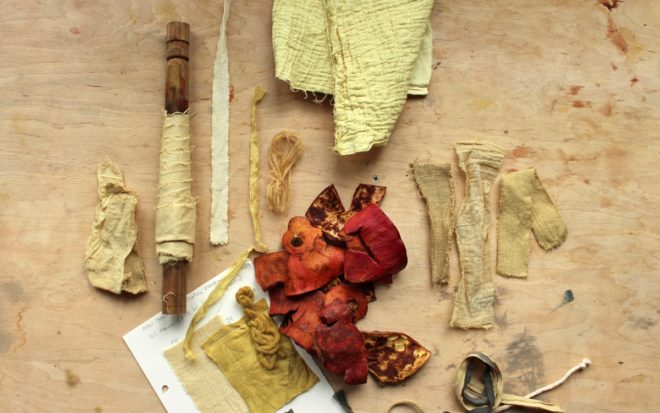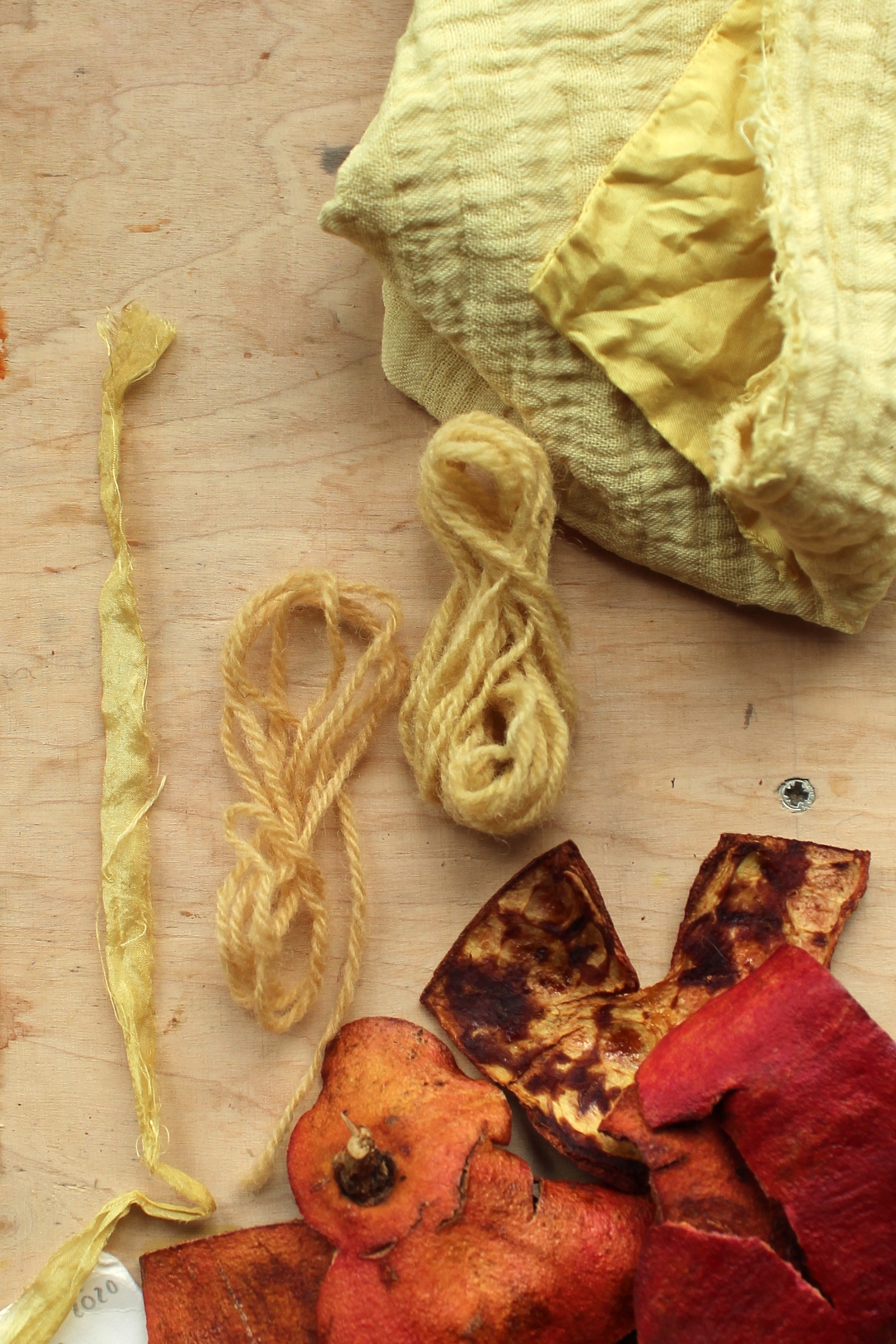Your basket is currently empty!

Kitchen dyes: Dyeing with pomegranate
Pomegranate as a dye? There are quite a few fugitive plants found in our kitchens. That are so inviting especially for first dye experiments, like red cabbage or beet root – yet not colourfast. But pomegranate peels are a trustworthy and traditional source of dye.
I dislike using vegetables or fruit for dyeing, but I love finding a use for scraps like pomegranate peels. First into the dye pot, than to the compost! I love "zero waste" dyes like that.
Pomegranate trees (Punica granatumare not native where I live. Their home is West/Central Asia but they have been cultivated in the Mediterranean for a very long time. Today they are grown pretty much around the globe wherever climate allows for it. The trees can stand light frost. In Germany they need some protection to overwinter, unless your garden is in an especially mild growing location.
Pomegranate peels as dye plants have a long history in the Mediterranean and West Asia, and can yield pale beige, bright or golden yellow, ocher and greys to blacks. There are some very old instructions for dyeing with pomegranate peels, dating to the neo-Babylonian period (626 to 539 BC), more on that can be found in Dominique Cardon’s Natural Dyes.
Bark and roots were also used for dyeing. In addition, they were also used medicinally. Humans and pomegranate trees have a long and multifaceted history.


Möchtest du mehr über Pigmente aus Pflanzenfarben? Und hier findest du den Workshop zum Drucken mit Pflanzenfarben.
Zero waste: Compost colours, even in winter
Because I was curious about dyeing with the peels, I once asked at a juice stall at the weekly market if I could have some pomegranate peels. And after some explanations I was allowed to get some in my bag. You will most likely find a vendor offering orange and pomegranate juice, too! Just kindly ask them for the peels. It is also one of the few dye plants that can be found here in winter, although not in the wild.
Drying pomegranate peels for dyeing
Recipes usually refer to dried pomegranate peels. To thatend I scrape the skins thoroughly with a spoon to remove flesh and seeds, and then dry them with as little pulp as possible. So if you eat one pomegranate from time to time and only have a few peels and not a whole bag like I do, that's no problem either. Simply dry your peels one at a time and keep collecting until you have enough. Dried dye plants are easy to store. Best protected from sunlight, but airy so nothing gets damp and moldy. I use brown paper bags and cardboard boxes to store them.


Tannin rich dye plant
Pomegranate peels are a special dye plant because they contain a high proportion of tannins. In many plants that dye yellow, flavonoids are responsible for this, but not here.
Tannins have a dual function in dyeing. Not only as a dye, but often they are also used in the pre-mordanting process. They can deepen colors and make them more colourfast.
And in pomegranate peels they are the reason why you can also use it to dye unmordanted fibers and still get fast colours: a rather delicate yellow or beige-yellow. With aluminum mordants it turns a stronger golden yellow and with iron the tannins react to shades of gray to black.

Dyeing with pomegranate peels
Most recipes I saw recommend equal weight of fiber and dyestuff.
I mostly dyed with dried peel, sometimes with a higher WOF percentage - the colors didn't get much more intense, I found them a bit duller perhaps. If the peels were dry but still quite "new", I got somewhat cleaner yellow tones. With peels that had been stored for a few years, I found the tones to be less bright, a little more towards ocher. If you noticed this too, or if you can't confirm it at all, please write me a comment. I'm very interested to know if others have made this observation too!
For comparison I also dyed with fresh peels that had only dried overnight. The colors were more delicate, a beautiful clear yellow. (When using fresh plants for dyeing, remember to use a higher WOF % than with dry plants. They contain a lot of water, which makes them heavier.)
For dyeing, break or crush the dry peel into smaller pieces. I like to soak them overnight before gently heating them the next day and then dyeing as usual.
In Eberhard Prinz‘ Buch Dye plants* (hier schon empfohlenalso mentions that flowers and peels of unripe fruit dye red tones. I could not test that so far, but maybe you have that opportunity.
I was also interested whether a cold extraction would shift colours. To test this I cut up fresh peels and soaked them in water for a few days. This dye bath looked indeed redder than the hot extraction. But from all the fibers I dyed, only the wool yarn looked different, a bit more reddish. Of course, the hot extraction is quicker and yields more dye in the process.



Mehr lesen über den Granatapfel
I looked up the pomegranate in the book 'Natural Dyes. Sources, Tradition, Technology and Science' by Dominique Cardon. Three pages are dedicated to the tree. If you are interested in the history of dye plants, dyeing methods and the "behind the scenes" chemistry of dyeing, this is a really exciting book. I read it very slowly (it's over 700 pages), and otherwise use it as a reference book. The original is French and it has been translated into English but not into German as far as I know. If you're looking for a comparable tome, but in German, maybe Helmut Schweppe's 'Handbuch der Naturfarbstoffe' (see here) is what you're looking for.
Above all, I came across another title in the bibliography of Cardon's book that made me curious. The pomegranate has a rich cultural history, is a symbol of fertility and life, among other things, and now 'Der Granatapfel. Symbol des Lebens in der alten Welt' by Friedrich Muthmann, 1982, is on my reading list – which hasn't been translated, I think.
Have you dyed with pomegranate yet? Or do you maybe have another pomegranate reading suggestion for me?
*Wenn du ein Buch über den Link kaufst, bekomme ich eine kleine Provision von meinem Partner buch7.de, der Preis für dich bleibt gleich. Die Bestellung über den sozialen Buchhandel buch7.de unterstützt soziale, kulturelle und ökologische Projekte.
Leave a Reply